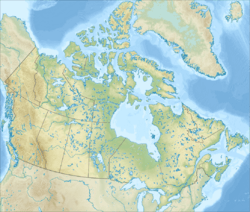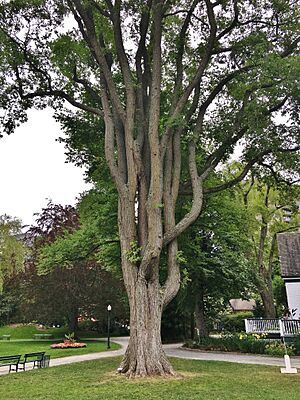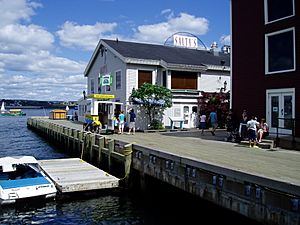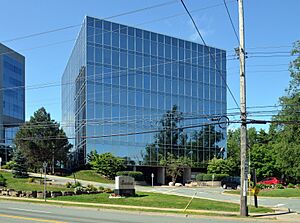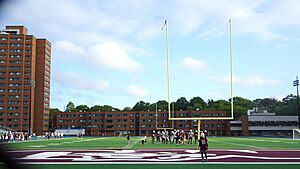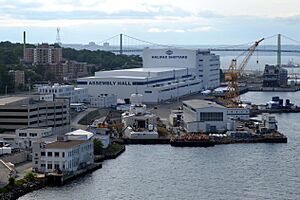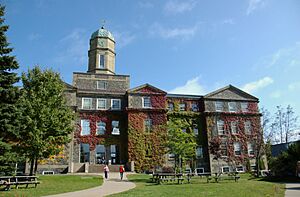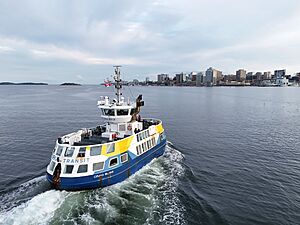Halifax, Nova Scotia facts for kids
Quick facts for kids
Halifax
|
|||||
|---|---|---|---|---|---|
| Halifax Regional Municipality | |||||
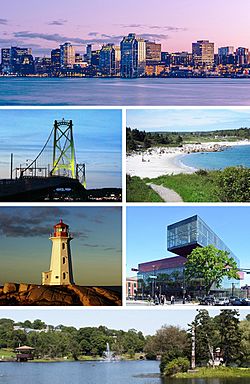
From top, left to right: Downtown Halifax skyline, Macdonald Bridge, Crystal Crescent Beach, Peggy's Cove, Central Library, Sullivan's Pond
|
|||||
|
|||||
| Motto(s): | |||||

Location in Nova Scotia
|
|||||
| Country | Canada | ||||
| Province | Nova Scotia | ||||
| Town | 1749 | ||||
| City | 1842 | ||||
| Regional municipality | April 1, 1996 | ||||
| Named for | George Montagu-Dunk, 2nd Earl of Halifax | ||||
| Government | |||||
| • Type | Regional municipality | ||||
| Area | |||||
| • Regional municipality | 5,475.57 km2 (2,114.13 sq mi) | ||||
| • Urban | 238.29 km2 (92.00 sq mi) | ||||
| • Metro | 7,276.22 km2 (2,809.36 sq mi) | ||||
| Highest elevation | 241.9 m (793.6 ft) | ||||
| Lowest elevation | 0 m (0 ft) | ||||
| Population
(2021)
|
|||||
| • Regional municipality | 439,819 (13th) | ||||
| • Density | 80.3/km2 (208/sq mi) | ||||
| • Urban | 348,634 | ||||
| • Urban density | 1,463.1/km2 (3,789/sq mi) | ||||
| • Metro | 465,703 (12th) | ||||
| • Metro density | 64.0/km2 (166/sq mi) | ||||
| • Change 2016–2021 | |||||
| • Census ranking | 13 of 5,162 | ||||
| Demonym(s) | Haligonian | ||||
| Gross Metropolitan Product | |||||
| • Halifax CMA | CA$24.4 billion (2020) | ||||
| Time zone | UTC−04:00 (AST) | ||||
| • Summer (DST) | UTC−03:00 (ADT) | ||||
| Postal code span |
B0J, B3A to B4G
|
||||
| Area codes | 902, 782 | ||||
Halifax is the capital city of Nova Scotia, a province in Canada. It's also the biggest city in Atlantic Canada. In 2023, about 518,711 people lived in the greater Halifax area. The city itself has about 348,634 residents.
Halifax is a major economic hub for Atlantic Canada. Many government offices and private businesses are located here. Big employers include the Canadian Armed Forces, Dalhousie University, and the Port of Halifax. In the rural areas, people work in farming, fishing, mining, and forestry.
Contents
History of Halifax
The Mi'kmaq people, who lived here first, called this place Kjipuktuk. It means "Great Harbour" in their language.
The first permanent European settlement was built in 1749. It was named Town of Halifax after the 2nd Earl of Halifax. This made Halifax the new capital, taking over from Annapolis Royal.
The British built forts to protect the new settlements. These included Citadel Hill in Halifax, Fort Sackville in Bedford, and forts in Dartmouth and Lawrencetown.
A huge disaster happened on December 6, 1917. A French ship carrying explosives, the SS Mont-Blanc, crashed into another ship in Halifax Harbour. The explosion, known as the Halifax Explosion, destroyed a large part of the city. About 2,000 people died, and nearly 9,000 were hurt. It was the biggest man-made explosion before nuclear weapons were invented.
In 1996, the four main areas of Halifax County (Halifax, Dartmouth, Bedford, and Halifax County) joined together. This created the Halifax Regional Municipality (HRM). Even though its official name is HRM, most people still just call it "Halifax."
Halifax's Geography and Climate
What is Halifax's Climate Like?
Halifax has a climate with warm summers and mild winters. This is because of the Gulf Stream, a warm ocean current. Temperatures usually stay between about -8°C and 28°C. January is the coldest month, and August is the warmest.
It rains or snows a lot all year. In winter, you'll see a mix of rain, freezing rain, and snow. Snowfall can be heavy, but it often melts quickly. Spring is usually cool and wet. Summers are mild and pleasant. Warm weather often lasts into September.
Halifax can sometimes get hurricanes, mostly from August to October. For example, Hurricane Juan hit in 2003, causing a lot of damage. Hurricane Fiona in 2022 caused downed trees and power outages.
The hottest temperature ever recorded was 37.2°C in July 1912. The coldest was -29.4°C in February 1922.
How is Halifax Organized?
Halifax has two main types of areas: rural and urban. Since 1996, all the towns, cities, and villages in Halifax County became part of the Halifax Regional Municipality. The total area of the municipality is about 5,475 square kilometers. This is similar in size to Prince Edward Island.
The coastline is very long, about 400 km, with many bays and harbours. The land ranges from green farmland in the Musquodoboit Valley to rocky, forested hills. Halifax also includes several islands, like McNabs Island and Sable Island.
The Regional Centre
The Halifax Regional Centre includes the Halifax Peninsula and parts of Dartmouth. This inner urban area is home to over 96,000 people. It has many public services, big entertainment places like the Scotiabank Centre, and major hospitals.
Communities and Neighbourhoods
Halifax is a big area with over 200 official communities. These range from quiet rural spots to busy urban areas. Places like Bedford, Dartmouth, and the original city of Halifax still use their old names. Many areas that were once rural are now more urban, like Cole Harbour and Lower Sackville.
These community names are used for maps, 9-1-1 services, and mail. Many communities now have their own business areas. This means people don't have to travel far to get what they need.
Rural Areas
The rural areas of Halifax are less populated. They are found to the east, west, and north of the city's main urban core. Some rural communities close to the city are like suburbs, with people commuting to work in the city.
Further out, rural communities rely on natural resources. These include agriculture in the Musquodoboit Valley, fishing along the coast, mining in places like Moose River Gold Mines, and forestry. Tourism is also growing in rural areas, especially in places like Peggys Cove with its famous lighthouse, and Lawrencetown with its beach.
Culture in Halifax
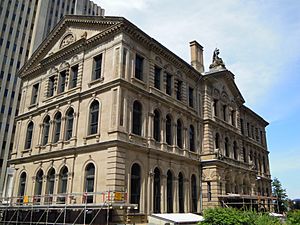
Halifax is a big cultural centre in Atlantic Canada. It keeps its maritime and military traditions. The city also has a growing mix of cultures. Many university students live here, which adds to the lively cultural scene.
Halifax has many art galleries, theatres, and museums. It also has the region's best sports and entertainment places. Some popular spots include the Art Gallery of Nova Scotia, the Maritime Museum of the Atlantic, and the Neptune Theatre. The city is also known for its great music scene and nightlife.
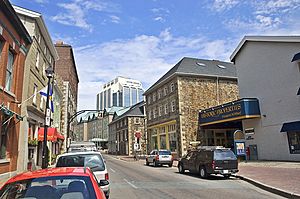
Halifax hosts many festivals all year. These include Canada Day celebrations, the Atlantic Film Festival, and the Halifax International Busker Festival. Halifax Pride is the biggest LGBT event in Atlantic Canada. Many of Halifax's events are now famous around the world.
The Neptune Theatre is Halifax's largest theatre, showing professional plays. The Shakespeare by the Sea company performs outdoors at Point Pleasant Park.
Halifax is also a popular place for filming movies and TV shows. The Canadian Broadcasting Corporation (CBC) has its Atlantic Canada production centres here. The new Halifax Central Library is famous for its cool design and offers many community activities.
Halifax's Architecture
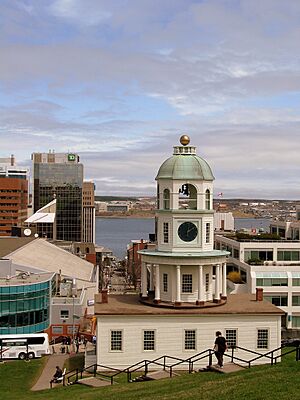
Halifax's city centre has many important buildings, both old and new. The modern office towers are overlooked by the historic Citadel Hill and its famous Halifax Town Clock.
The South End of Halifax is known for its large Victorian houses. The West End and North End, Halifax have many well-preserved wooden houses. Some parts of downtown have height limits for buildings. This is to make sure buildings don't block the views between Citadel Hill and the Halifax Harbour.
Public Spaces and Parks
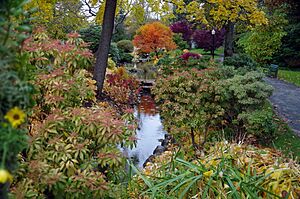
Halifax has many public spaces. These include city gardens, public squares, large parks, and historic sites. The Grand Parade is a central square where City Hall is located. It's used for concerts and ceremonies. The Halifax Boardwalk is a popular 3 km path along the waterfront with shops and monuments.
The Halifax Common is Canada's oldest public park, used for sports and relaxing. The Halifax Public Gardens are beautiful Victorian gardens, made a National Historic Site in 1984. Point Pleasant Park is a large, forested park with old British forts.
Across the harbour, the Dartmouth Commons is a big park near Downtown Dartmouth. Shubie Park in suburban Dartmouth has the historic Shubenacadie Canal.
On the mainland, Sir Sandford Fleming Park has the Dingle Tower. Long Lake Provincial Park offers a wilderness area close to the city.
Tourism in Halifax

Halifax's tourism shows off Nova Scotia's culture and scenery. There are many museums and art galleries downtown. The Canadian Museum of Immigration at Pier 21 tells the story of immigrants coming to Canada. The Maritime Museum of the Atlantic has exhibits on ships, including the Titanic.
The preserved World War II ship HMCS Sackville is a museum. The Art Gallery of Nova Scotia has almost 19,000 artworks. The Black Cultural Centre for Nova Scotia in Dartmouth shares the region's rich Black heritage.
Halifax has many National Historic Sites, like Citadel Hill (Fort George). Just outside the city, Peggys Cove is famous worldwide and gets over 600,000 visitors each year.
The Halifax Boardwalk is a 3 km path along the harbour. It's popular with both tourists and locals. You'll find shops, restaurants, and the Casino Nova Scotia here. Downtown Halifax has many small shops and over 200 restaurants and bars.
Cruise ships visit Halifax often. In 2015, the port welcomed 141 ships with over 222,000 passengers.
Media in Halifax
Halifax is the main centre for radio and print media in Atlantic Canada. Major TV networks like CBC, CTV, and Global have regional offices here.
Halifax's main newspaper is The Chronicle Herald. There are also free newspapers like Metro International and the arts weekly The Coast. Several online newspapers also cover local news.
Sports in Halifax
Halifax has two professional sports teams and one semi-professional team. The city is also home to four universities with sports programs.
The main sports venues include the Scotiabank Centre, the Halifax Forum, and the Wanderers Grounds.
Professional and Semi-Professional Teams
The Halifax Mooseheads are a semi-professional junior hockey team in the Quebec Maritimes Junior Hockey League (QMJHL). They started in 1994. In 2013, they won the QMJHL's President's Cup and the Memorial Cup.
The Halifax Thunderbirds are the city's professional National Lacrosse League team. They moved to Halifax in 2018. In their first full season (2021-2022), they made it to the playoffs.
Halifax's other professional team is the HFX Wanderers FC. They play in the Canadian Premier League, Canada's top soccer league. They started playing in 2019 at a temporary stadium on the Wanderers Grounds.
| Club | League | Sport | Venue | Established | Championships |
|---|---|---|---|---|---|
| Halifax Mooseheads | QMJHL | Major Junior Hockey | Scotiabank Centre | 1994 | 1 (last in 2013) |
| Halifax Thunderbirds | NLL | Box Lacrosse | Scotiabank Centre | 2019 | 0 |
| HFX Wanderers FC | CPL | Soccer | Wanderers Grounds | 2018 | 0 |
University Sports
Halifax has four universities with athletic programs. Dalhousie University and Saint Mary's University are part of the U Sports league. Mount Saint Vincent University and University of King's College are part of the Canadian Collegiate Athletic Association (CCAA).
Dalhousie's teams are called the Tigers. They play basketball, hockey, soccer, swimming, and more. Saint Mary's University's teams are the Huskies. Their football team is well-known, winning national championships in 2001 and 2002.
Major Sporting Events
Halifax has hosted many big sports events over the years:
- 2003 World Junior Ice Hockey Championships
- 2004 Women's World Ice Hockey Championships
- 2008 IIHF World Championship (with Quebec City)
- 2011 Canada Winter Games
- 2023 World Junior Ice Hockey Championships (with Moncton)
- 2023 North American Indigenous Games
Population and People
Halifax's Population Growth
| Historical populations | ||
|---|---|---|
| Year | Pop. | ±% |
| 1851 | 39,914 | — |
| 1861 | 49,021 | +22.8% |
| 1871 | 56,963 | +16.2% |
| 1881 | 67,917 | +19.2% |
| 1891 | 71,358 | +5.1% |
| 1901 | 74,662 | +4.6% |
| 1911 | 80,257 | +7.5% |
| 1921 | 97,228 | +21.1% |
| 1931 | 100,204 | +3.1% |
| 1941 | 122,656 | +22.4% |
| 1951 | 162,217 | +32.3% |
| 1961 | 225,723 | +39.1% |
| 1971 | 261,461 | +15.8% |
| 1981 | 288,126 | +10.2% |
| 1991 | 332,518 | +15.4% |
| 1996 | 342,966 | +3.1% |
| 2001 | 359,183 | +4.7% |
| 2006 | 372,858 | +3.8% |
| 2011 | 390,096 | +4.6% |
| 2016 | 403,131 | +3.3% |
| 2021 | 439,819 | +9.1% |
| Before 1996, the figures are for Halifax County. From 1996 onwards, the figures are for Halifax Regional Municipality. Source: Statistics Canada |
||
In 2021, the Halifax Regional Municipality had a population of 439,819 people. This was a 9.1% increase from 2016. The greater Halifax area (CMA) had 465,703 people.
Many people living in Halifax were born outside Canada. In 2021, about 50,595 residents were immigrants. The top countries they came from include the United Kingdom, India, China, and the United States.
Different Backgrounds in Halifax
Halifax is home to people from many different backgrounds. The largest group is of European heritage. There are also significant communities of African, South Asian, Indigenous, East Asian, and Middle Eastern people. This mix of cultures makes Halifax a diverse place.
Languages Spoken in Halifax
English is the main language spoken in Halifax. In 2021, about 86.4% of people spoke English as their first language. French is the second most common, followed by Arabic, Mandarin, and Punjabi.
Religions in Halifax

Halifax has many different religions. Christianity is the largest religion, followed by people who do not identify with a religion. There are also communities of Muslims, Hindus, Buddhists, and Jewish people.
Some important religious buildings include St. Paul's Church (the oldest Christian church), St. Mary's Basilica, and the Beth Israel Synagogue.
Halifax's Economy
Halifax is a big economic centre in eastern Canada. It has many government services and private companies. Halifax is the main business, banking, and cultural centre for the Maritime region.
Major employers include the Department of National Defence, the Port of Halifax, and Irving Shipbuilding. The city's economy is growing. Halifax is one of Canada's top four container ports, handling a lot of cargo.
In rural areas, the economy relies on natural resources. Farming is big in the Musquodoboit Valley. Fishing harbours are found all along the coast. Mining for things like gold and limestone also happens in rural parts of the municipality.
Education in Halifax
Halifax has many public and private schools for students from primary to grade twelve. The public schools are managed by the Halifax Regional Centre for Education.
The city is also a major centre for university education. It is home to several universities:
- Dalhousie University (the largest and a top research university)
- University of King's College
- Mount Saint Vincent University
- NSCAD University (for art and design)
- Saint Mary's University
- Atlantic School of Theology
Many students come to Halifax for university, which adds to the city's lively youth culture.
Transportation in Halifax
Air Travel
The Halifax Stanfield International Airport serves Halifax and most of Nova Scotia. It has flights to places in Canada and other countries. In 2022, over 3.1 million passengers used the airport.
Biking Around Halifax
Halifax has been working to improve its biking paths. There are now about 100 km of bikeways, with 89 km being dedicated bike lanes.
Roads and Bridges
The city's main urban areas are connected by the Macdonald and MacKay suspension bridges. There's also a network of highways that act like expressways.
Public Transit
Public transportation is provided by Halifax Transit. They operate bus routes and the Halifax-Dartmouth Ferry Service. The ferry service, started in 1752, is the oldest continuously running saltwater ferry in North America.
Halifax has the busiest public transit system in Atlantic Canada. The city is adding special bus lanes to make the system faster and more reliable.
Rail and Water Transport
The Port of Halifax is a major port for shipping. It's the eastern end of the Canadian National Railway's cross-Canada network. Via Rail Canada offers passenger train service from Halifax to Montreal three days a week.
The Royal Canadian Navy and the Canadian Coast Guard have large bases in Halifax Harbour. The harbour is also used by a public ferry service connecting Halifax and Dartmouth.
Sister Cities
Halifax has "sister city" relationships with other cities around the world. These partnerships help build friendships and cultural exchange.
- Hakodate, Japan (since 1982): Both cities have star-shaped forts and are port cities.
- Campeche, Mexico (since 1999): Both are state capitals and coastal cities with rich history.
- Norfolk, Virginia, United States (since 2006): Both cities have strong military ties and proud military histories.
- Portsmouth, England (since 2023): Both are historic naval and shipbuilding centres, and have universities.
Images for kids
See also
 In Spanish: Halifax para niños
In Spanish: Halifax para niños




